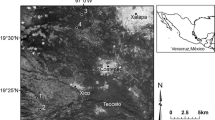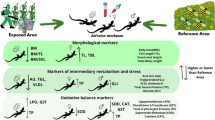Abstract
We analyzed six organochlorine compounds (HCB, lindane, p,p’-DDE, PCB # 138, #153, and # 180) from populations of the European great tit (Parus major) and from five species of bats (Pipistrellus pipistrellus, Nyctalus noctula, Plecotus auritus, Plecotus austriacus, Myotis myotis). A weak positive correlation between Kow (n-octanol /water partition coefficient) and bioaccumulation (measured as residue values) was found within each species. However, the ratio of the concentrations in bats compared to titmice increased significantly with increasing Kow. We argue that this is explained by the intensive juvenile feeding through long-term lactation and thus by the more intensive transfer of strongly lipophilic xenobiotics from mother to juvenile in mammals compared to birds. Further, there were clear variations between bat species with ranges of up to 11 times the lowest value for a single compound. These differences are related to different feeding habits of the adults and to different species-specific life history traits, such as age at maturity and number of offspring.
Similar content being viewed by others
References
Ariyoshi, N.;Koga, N.;Oguri, K.;Yosimura, H. (1992): Metabolism of 2,4,5,2’,4’,5’-hexachlorobiphenyl with liver microsomes of phenobarbital-treated dog: The possible formation of PCB 2,3-arene oxide intermediate. Xenobiotica 22: 1275–1290.
Bauer, H. G.;Hölzinger, J.;Nagl, W.;Reinhardt, H.;Schuster, S. (1991): Qualitative Brutvogelerfassung Baden-Württemberg 1987/88 — Hochrechnung der Gesamtbestände. Naturschutzforum 3/3: 123–148.
Borlakoglu, J. T.;Wilkins, J. P. G. (1993): Metabolism of di-, tri-, tetra-, penta- and hexachlorobiphenyls by hepatic microsomes isolated from control animals and animals treated with Aroclor 1254, a commercial mixture of polychlorinated biphenyls (PCBs). Comp. Biochem. Physiol. 105C: 95–125.
Braun, M. (1986): Rückstandsanalysen bei Fledermäusen. Zeitschrift für Säugetierkunde 51: 212–217.
Bunck, C. M.;Prouty, R. M.;Krynitsky, A. J. (1987): Residues of organochlorine pesticides and polychloribiphenyls in starlings (Sturnus vulgaris), from the continental United States, 1982. Environmental Monitoring and Assessment 8: 59–75.
Clark, D. R. (1978): Uptake of dietary PCB by pregnant big brown bats (Eptesicus fuscus) and their fetuses. Bull. Environm. Contam. Toxicol. 19: 707–714.
Clark, D. R.;Prouty, R. M. (1976): Organochlorine residues in three bat species from four localities in Maryland and West Virginia, 1973. Pestic. Monk. J. 10: 44–53.
Clark, D. R.;Lamont, T. G. (1976): Organochlorine residues in females and nursing young of the big brown bat (Eptesicus fuscus). Bull. Environm. Contam. Toxicol. 15: 1–8.
Clark, D. R.;Kunz, T. H.;Kaiser T. E. (1978): Insecticides applied to a nursery colony of little brown bats (Myotis lucifugus): Lethal concentrations in brain tissues. J. Mamm. 59: 84–91.
Daelemans, F. F.;Mehlum, F.;Schepens, P. J. C. (1992): Polychlorinated biphenyls in two species of arctic seabirds from the Svalbard area. Bull. Environ. Contam. Toxicol. 48: 828–834.
Disser, J.;Nagel, A. (1989): Polychlorinated biphenyls in a maternity colony of the common pipistrelle (Pipistrellus pipistrellus). In: European Bat Research 1987, eds.V. Hanak, I. Horacek, J. Gaisler. Charles University Press, Praha, 637–644.
Disser, J.;Brunn, H.;Nagel, A.;Prinzinger, R. (1992): Untersuchungen zur Belastung von Vogeleiern mit Chlorkohlenwasserstoffen unter besonderer Berücksichtigung der PCBs. Ökologie der Vögel (Ecology of Birds) 14: 173–209.
Drescher-Kaden, U.;Hutterer, R. (1981): Rückstände an Organohalogenverbindungen (CKW) in Kleinsäugern verschiedener Lebensweise — Untersuchungen an Wildfängen und Fütterungsversuche. Ökol. Vögel 3: 127–142.
Frank, H.;Nagel, A.;Weigold, H. (1980): Bestandsentwicklung der in Höhlen überwinternden Fledermäuse auf der Schwäbischen Alb. Die Höhle 31: 112–116.
Glutz von Blotzheim, U. N.;Bauer, K. M. (1993):Parus major Linnaeus 1758 — Kohlmeise. In: Handbuch der Vögel Mitteleuropas 13/I: 678–808. Aula, Wiesbaden.
Hawker, D. W.;Connell, D. W. (1988): Octanol-water partition coefficients of polychlorinated biphenyl congeners. Environ. Sci. Technol. 22: 382–387.
Mason, C. F.;MacDonald, S. M.;Bland, H. C.;Ratford, J. (1992): Organochlorine pesticide and PCB contents in otter (Lutra lutra) scats from Western Scotland. Water, Air, and Soil Pollution 64: 617–626.
Müller, P. (1985): Zur Rückstandssituation bei freilebenden Tieren der Bundesrepublik Deutschland. Mitteil. Fachricht. Biogeographie Univ. Saarland. Saarbrücken. 15: 1–54.
Müller, E. (1993): Fledermäuse in Baden-Württemberg II. Eine Kartierung durch die AG Fledermausschutz Baden-Württemberg in den Jahren 1986–1992. Beih. Veröff. Naturschutz Landschaftspflege. Bad.-Württ. 75: 9–96.
Nagel, A.;Disser, J. (1987): Untersuchungen zur Belastung einer Wochenstube von Zwergfledermäusen (Pipistrellus pipistrellus) mit Chlorkohlenwasserstoffen. Verh. Dt. Zool. Ges. 80: 215–216.
Nagel, A.;Disser, J. (1990): Rückstände von Chlorkohlenwasserstoff-Pestiziden in einer Wochenstube der Zwergfledermaus (Pipistrellus pipistrellus). Zeitschrift für Säugetierkunde 55: 217–225.
Nagel, A.;Nagel, R. (1991 a): Bestandsentwicklung überwinternder Fledermäuse auf der Schwäbischen Alb von 1979/80 bis 1989/90. Zeitschrift für Säugetierkunde, Sonderheft, 56: 35–36.
Nagel, A.;Winter, S.;Streit, B. (1991): Residues of chlorinated hydrocarbons in six European bat species. Bat Research News 32: 20–21.
Nagel, R.;Loskill, R. (1991): Bioaccumulation in Aquatic Systems. VCH, Weinheim.
Neubert, D. (1994): Reproduktion und Entwicklung. S. 313–349. In:Marquardt, H. &Schäfer, S.G.: Lehrbuch der Toxikologie. BI Wissenschaftsverlag, Mannheim.
Neuweiler, G. (1993): Biologie der Fledermäuse. G. Thieme, Stuttgart 1993.
Perry, A. S.;Sidis, I.;Zemach, A. (1990): Organochlorine insecticide residues in birds and bird eggs in the coastal plain of Israel. Bull. Environ. Contam. Toxicol. 45: 523–530.
Roer, H. (1981): Zur Bestandsentwicklung einiger Fledermäuse in Mitteleuropa. Myotis 18/19 60–67.
Streit, B. (1992): Bioaccumulation processes in ecosystems. Experientia 48: 955–970.
Streit, B. (1994): Lexikon Ökotoxikologie. 2. Aufl. VCH Weinheim, XXI + 901 pp.
Streit, B.;Nagel, A. (1993): Element assessment in tissue samples from European bats. Fresenius Environmental Bulletin Vol. 2: 162–167.
Streit, B.;Nagel, A. (1993): Heavy metal transfer by lactation in a bat colony. Fresenius Environmental Bulletin Vol. 2: 168–173.
Streit, B.;Siré, E.-O.;Kohlmaier, G. H.;Badeck, F.-W.;Winter, S. (1991): Modelling ventilation efficiency of teleost fish gills for pollutants with high affinity to plasma proteins. Ecol. Modelling 57: 237–262.
Streit, B.;Sire, E.-O. (1993): On the role of blood proteins for uptake, distribution, and clearance of waterborne lipophilic xenobiotics by fish: A linear system analysis. Chemosphere 26: 1031–1039.
Subramanian, A. N.;Tanabe, S.;Tanaka, H.;Hidaka, H.;Tat-Sukawa, R. (1987): Gain and loss rates and biological half-life of PCBs and DDE in the bodies of Adélie penguins. Environmental Pollution 43: 39–46.
Winter, S.;Streit, B. (1992): Organochlorine compounds in a three-step terrestrial food chain. Chemosphere 24: 1765–1774.
Author information
Authors and Affiliations
Corresponding author
Rights and permissions
About this article
Cite this article
Streit, B., Winter, S. & Nagel, A. Bioaccumulation of selected organochlorines in bats and tits: Influence of chemistry and biology. Environ. Sci. & Pollut. Res. 2, 194–199 (1995). https://doi.org/10.1007/BF02986762
Received:
Accepted:
Issue Date:
DOI: https://doi.org/10.1007/BF02986762




